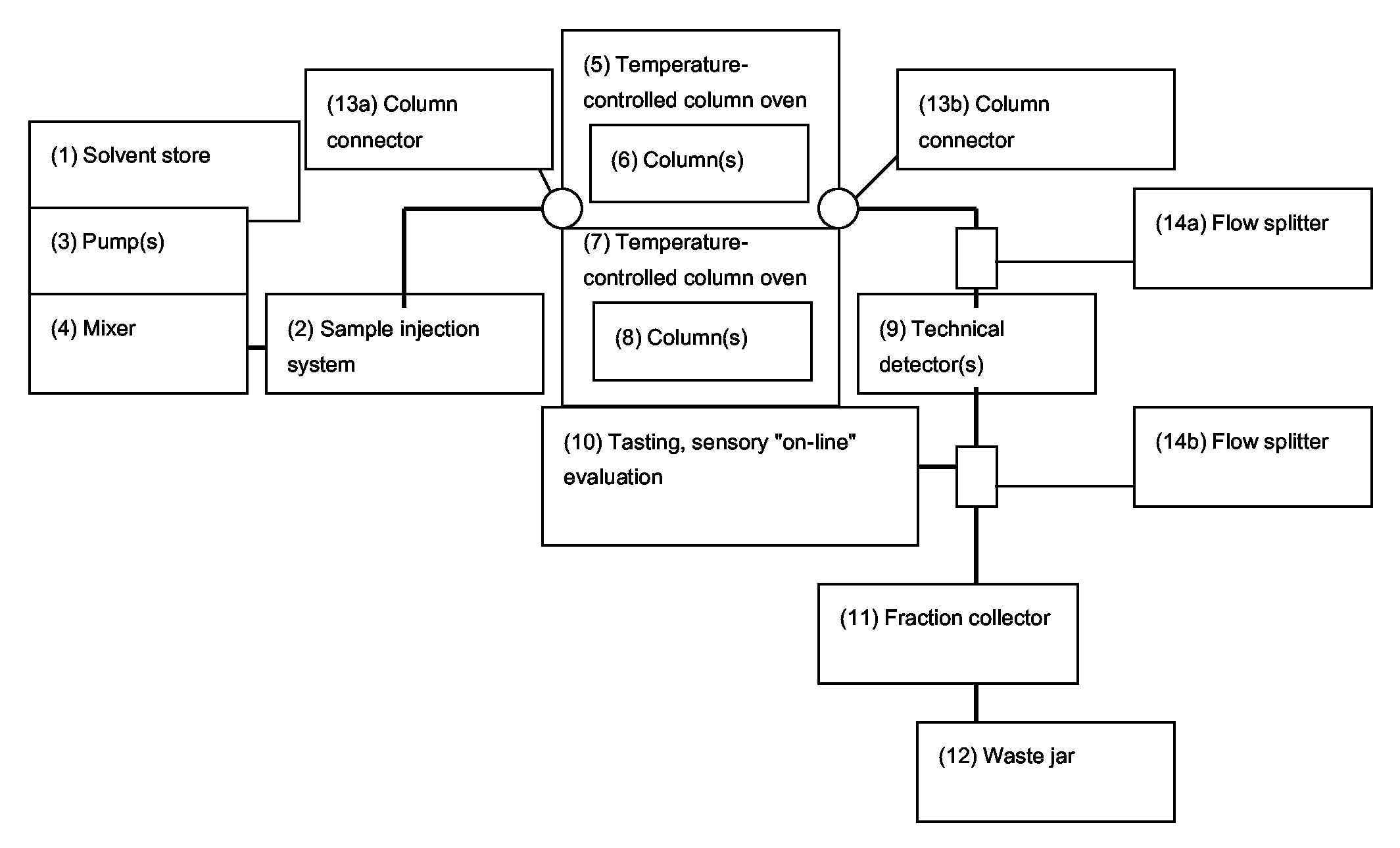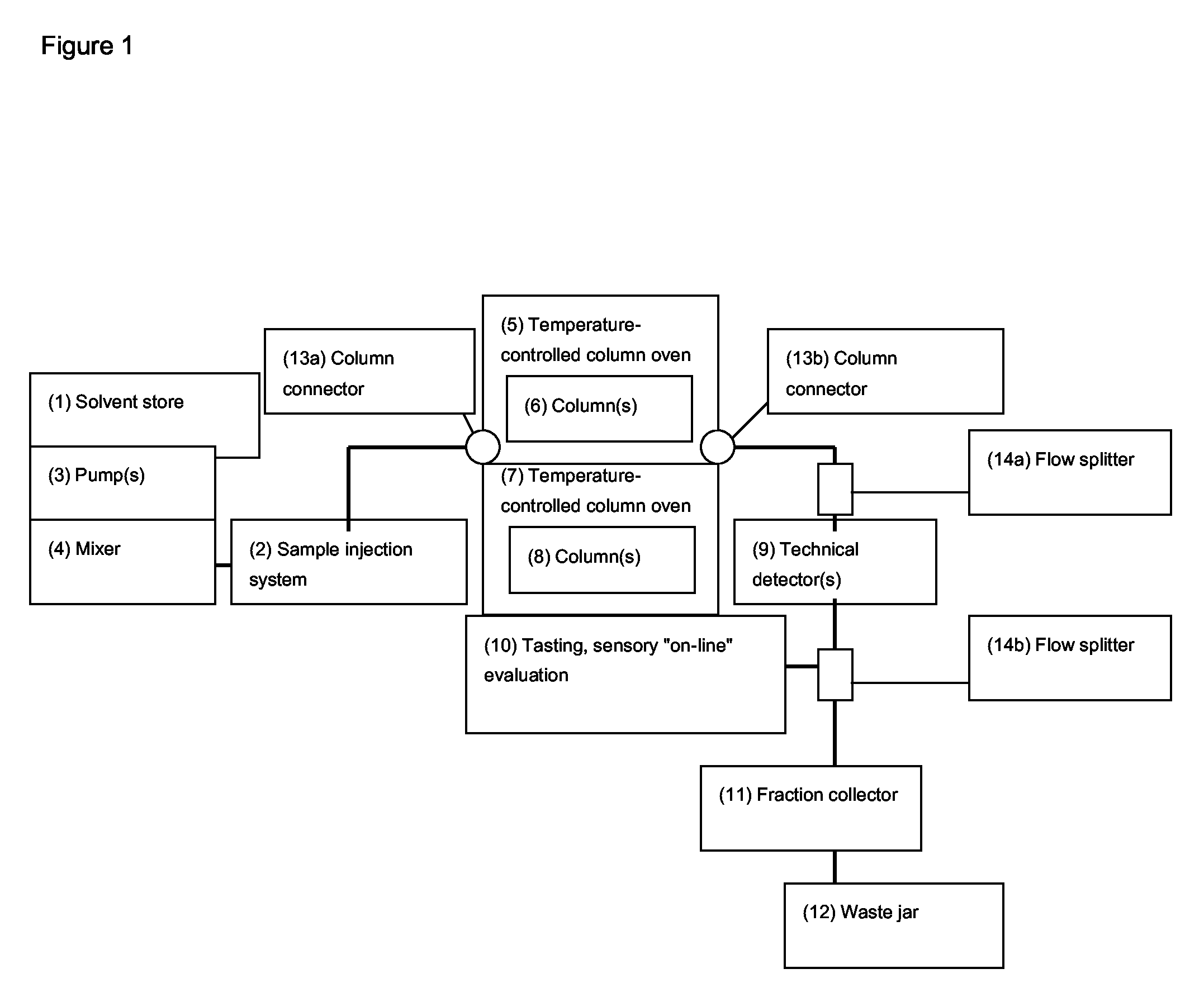Process for the separation and sensory evaluation of flavours using HTLC
a sensory evaluation and flavour technology, applied in the field of flavour separation and sensory evaluation of flavours using htlc, can solve the problem that sensory active components which cannot be recorded with technical detectors cannot be detected by conventional separation processes
- Summary
- Abstract
- Description
- Claims
- Application Information
AI Technical Summary
Benefits of technology
Problems solved by technology
Method used
Image
Examples
example 1
Device for Performing a Process According to the Invention
[0043]FIG. 1 shows a device for performing the process according to the invention. The device includes two HTLC columns (6, 8), wherein each of the columns is positioned in its own temperature-controlled oven (5, 7). At one sample injection end the columns (6, 8) are each connected via a column connector (13a), in particular a multidirectional valve, to a sample injection system (2), for example an autosampler. At one sample injection end the columns (6, 8) are each connected via a further column connector (13b), in particular a multidirectional valve, to one or more technical detectors (9), for example a refractive index detector (RI), an evaporative light-scattering detector (ELSD), a mass spectrometer detector (MS), a diode-array detector (DAD), a UV / Vis detector and / or a fluorescence detector (FLD). In the direction of flow before (14a) and / or after (14b) the technical detector(s) (9) there is a flow splitter to release a...
example 2
Testing of an Instant Cappuccino Product Using the Process According to the Invention
[0045]Preparation of a sample solution in water in a defined concentration.
[0046]The HTLC device for use according to the invention contains two column ovens (5, 7), each with a separating column (6, 8), wherein the first separating column (6) contains a polymer phase for the carbohydrate analysis and the second separating column (8) contains a polymer phase for the bitter principle analysis. The dimensions of the column used for the carbohydrate analysis are 250×8 mm and those of the column for the bitter principle analysis are 250×8 mm. A combined detector comprising an RI, ELSD and DAD is used as the technical detector (9).
[0047]The device according to the invention is conditioned with a flow of 1.5 ml / min of an eluent comprising 100% water.
[0048]The sample injection system (2) in the device is set to a sample injection quantity of 50 μl.
[0049]On completion of the conditioning step, chromatograph...
example 3
Testing of a Chocolate Extract Using the Process According to the Invention
[0053]An ethanolic extract of a chocolate is prepared and separated using an HTLC device for use according to the invention.
[0054]The HTLC device for use according to the invention contains a column oven (5) with a separating column (6). A polymer phase [Hamilton PRP-1 reversed phase HPLC column, spherical styrene-divinyl benzene copolymer, particle size: 10 μm, pore size 100 Å, dimensions (length×internal diameter): 250×10 mm] was used as the separating column. A combined detector comprising an RI, ELSD and DAD is used as the technical detector (9).
[0055]Elution was performed at a flow rate of 1 to 3 ml / min with an elution gradient, wherein a mixture comprising 95 wt. % water and 5 wt. % ethanol was used as eluent at the start and a mixture comprising 70 wt. % water and 30 wt. % ethanol at the end of the HTLC separation. The temperature of the stationary phase was raised continuously during the HTLC separati...
PUM
| Property | Measurement | Unit |
|---|---|---|
| temperature | aaaaa | aaaaa |
| temperature | aaaaa | aaaaa |
| pressure | aaaaa | aaaaa |
Abstract
Description
Claims
Application Information
 Login to View More
Login to View More - R&D
- Intellectual Property
- Life Sciences
- Materials
- Tech Scout
- Unparalleled Data Quality
- Higher Quality Content
- 60% Fewer Hallucinations
Browse by: Latest US Patents, China's latest patents, Technical Efficacy Thesaurus, Application Domain, Technology Topic, Popular Technical Reports.
© 2025 PatSnap. All rights reserved.Legal|Privacy policy|Modern Slavery Act Transparency Statement|Sitemap|About US| Contact US: help@patsnap.com


